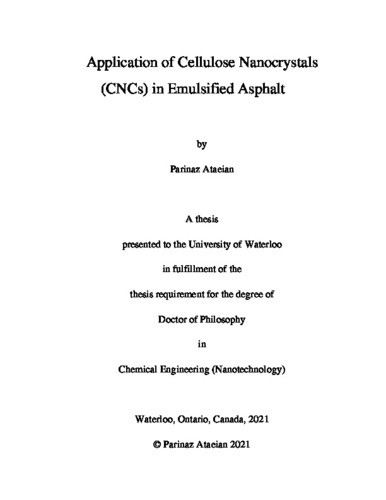| dc.description.abstract | In today's world, transportation infrastructure plays a vital role in global competitiveness and the quality of life in societies. A considerable fraction of taxpayers' money is spent on expanding and maintaining road networks each year. The pavement industry deals with tremendous amounts of construction materials and mathematically speaking, even a tiny improvement in the quality of construction material can lead to significant environmental benefits and reduce the life-cycle cost of road networks. Asphalt cement is an integral part of road pavements, and despite favorable properties at performance temperature, its viscosity should be reduced at the production stage to make it processable. The most common approach used today is to reduce the viscosity by raising the temperature of the asphalt, which is expensive and energy-intensive. The emulsification of asphalt in water using surfactant-based technologies has been used in the pavement industry for decades. Significant modifications have been applied over time, and various formulations have been developed, leading to safer and more environmentally friendly pavement construction and maintenance techniques. The most common applications of asphalt emulsions are cold recycling of asphalt pavement, tack-coat to bind successive layers, soil treatments, and cold surface treatments, such as micro-surfacing, cheap sealing, and fog sealing. However, due to the complicated chemistry and high-temperature sensitivity of the rheological behavior of asphalt cement, emulsified asphalt still suffers from practical limitations in either production, storage, or application. The asphalt cement's significant physical state changes throughout the production and application temperature range imposes strict production, storage, and application conditions. Inevitable deviation of required conditions could lead to loss of stability in the system and material waste. Such practical problems in conjunction with limited rheological properties have limited the application of emulsified asphalt in many applications.
The current asphalt emulsions in the pavement industry use ionic surfactants to stabilize the asphalt particles, and the charge of the surfactants is pH-dependent. When mixed with aggregates, multivalent ions of the aggregates would neutralize these surfactants and destabilize the asphalt emulsions. More importantly, the stability of such systems is extremely sensitive to storage conditions, and any changes will result in the partial or total destabilization of the system. Unlike surfactant-based technologies, the Pickering emulsion stability is achieved through a solid barrier
vi
that prevents the oil droplets from coalescing. Pickering emulsions are less sensitive to the pH of the environment, making them more compatible with mixed aggregates.
Cellulose nanocrystals (CNCs) are nanoscale cellulose in crystalline form produced from the acid hydrolysis of cellulose microfibrils and the removal of the amorphous domains. Several specific features have been attributed to CNCs, including high tensile strength, biodegradability, non-toxic, low cost, and large surface area. As a result of their renewability, low density, nanoscale dimension, non-hazardous nature, and competitive price, CNCs find broad application for a diverse range of products. CNCs have been used successfully as Pickering emulsifying agents mainly in the cosmetic industry due to their amphiphilic properties, low surface charge, and large aspect ratio.
Due to their structural form (nanoscale fiber) and mechanical properties, CNCs have been shown to enhance the mechanical properties of formulations, such as tensile strength, elastic behavior, and ageing. Such properties could also benefit asphalt cement for pavement application by delaying the crack initiation, improving resistance to permanent deformation, and reducing age-related changes.
In this doctoral research, various aspects on the CNC-based asphalt Pickering emulsion preparation were studied. Viable chemical surface treatments on the surface of CNC were performed to enhance and adjust the rheological properties and stability of the resulting emulsified asphalt. The impact of CNC on the rheological and performance properties of asphalt cement was examined.
The partitioning behavior of CNC at the droplet's surface before and after phase transition was analyzed. As a first step, coconut oil and paraffin wax were used as a surrogate to improve laboratory emulsification process control to investigate the physicochemical characteristics of Pickering emulsions prepared using pristine CNC and modified CNC particles throughout the phase transition of the dispersed phase. The partitioning of CNC to the droplet interface during phase transition was monitored and elucidated through fluorescent labelling of CNCs with PAMAM G6 dendrimer and fluorescent microscopy.
Interface tension measurements were performed to evaluate the impact of surface charge on CNC partitioning at the interface. To reduce the interparticle electrostatic repulsion and achieve
vii
better surface coverage, the negative surface charge of CNCs was reduced by adding salt and with four different chemical modifications. The stability of the resulting systems was then evaluated under dynamic loading. A mathematical model for time-associated changes in the dynamic interfacial tension of oil in the presence of various modified and pristine CNCs was developed and used to investigate the surface coverage. The stability of CNC-based systems through the phase transition of the dispersed phase was evaluated and compared with a surfactant-base technology. Using particle size analysis in conjunction with an extensive rheological analysis on both systems through temperature sweep and dynamic loading revealed significantly improved stability for the CNC Pickering emulsions. A mathematical model describing the relationship between particle concentration and resulting droplet size in Pickering emulsions was developed and used to optimize the formulation composition. Complex viscosity measurements were used to compare the resistance of the two systems under dynamic loading.
The 2S2P1D analogical model facilitated the development of complex modulus master curves and rheological analysis of asphalt cement residues. The impact of free and unbound CNC in asphalt residue's rheological properties was compared to the residue of a surfactant-based system. Fundamental change in the rheological behavior was observed due to the free CNCs in the formulation. Phase angle master curve and black-space diagram revealed an elastic return point in the sample with CNC. It was concluded that the remaining CNCs could form a network at low shear strains, and the residue performed as a composite material with improved elastic behavior, especially at a high-performance temperature range. Multiple stress creep recovery tests revealed the improved resistance of CNC-containing samples in the non-linear viscoelastic region. | en |

